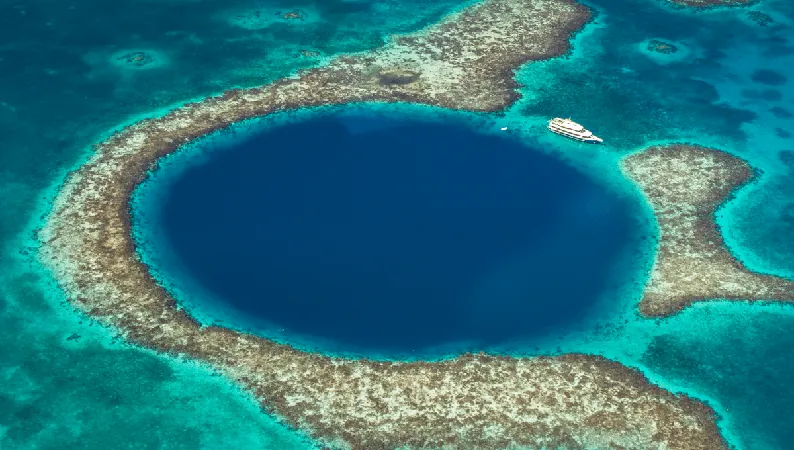
Scientists Uncover 5,700 Years of Hidden History by Drilling the Great Blue Hole!
2025-04-05
Author: Jacob
Incredible news from the depths of the ocean!
Scientists have just drilled into the iconic Great Blue Hole, located in the Lighthouse Reef Atoll, approximately 80 kilometers (50 miles) off Belize's coast, revealing an astonishing 5,700 years of climatic history. This massive marine sinkhole, with a depth of 124 meters (407 feet), presents a captivating site that looks like a dark blue gem from above.
The Significance of the Great Blue Hole
The Great Blue Hole isn’t just a beautiful tourist attraction; it holds secrets that date back to multiple glaciation periods when the area was dry land, allowing limestone cave formations. As sea levels rose and these caves submerged, they ultimately collapsed, forming the spectacular sinkhole we see today.
Sediment Accumulation and Historical Archive
Beginning around 20,000 years ago, sediment has steadily accumulated at the bottom of this underwater pit, creating a historical archive of the region’s weather events. In a groundbreaking expedition in the summer of 2022, scientists from Goethe University Frankfurt successfully retrieved a sediment core sample that measures 30 meters (98 feet) long, using a specialized drilling platform shipped directly to the site.
Insights into Ancient Climate Patterns
These sediment layers offer a glimpse into ancient climate patterns. Researchers focused on identifying layers called tempestites, which are indicators of severe weather events. By meticulously examining these layers, the team identified a staggering 574 storm events within the past 5,700 years, giving us insight into the tumultuous weather history of the region.
Environmental Conditions of the Great Blue Hole
Dr. Dominik Schmitt, the lead researcher of the study, described the unique environmental conditions of the Great Blue Hole: “With oxygen-free bottom water and several stratified layers of water, fine sediments could settle undisturbed, resembling tree rings in their annual layers.” Each layer varies in color—gray-green during calm weather and transitioning to beige or white during storm events.
Increase in Storm Frequency
Astoundingly, the analysis revealed that the frequency of tropical storms and hurricanes in this region has sharply escalated over the last six millennia. Statistically, the area has seen an average of four to 16 tropical storms and hurricanes per century; alarmingly, nine of these storms have occurred in the past two decades alone, indicating this century could bear witness to an unprecedented number of storms.
Implications of Climate Change
Professor Eberhard Gischler, head of the Biosedimentology Research Group, speculated that up to 45 tropical storms and hurricanes may impact the southwestern Caribbean over the current century, a rate far exceeding historical norms. This increase in storm activity is heavily influenced by the southward movement of the Intertropical Convergence Zone, a significant weather belt determining storm patterns, coupled with the rising sea temperatures that intensify storm ferocity.
A Crucial Warning for the Future
However, this isn't merely a cyclical natural phenomenon! The study asserts that the alarming uptick in storm frequency correlates directly with human-driven climate change. Since the onset of industrialization, conditions have become increasingly ripe for more frequent and powerful hurricanes, emphasizing the urgent need to address the impacts of climate change on our environment.
Conclusion
This groundbreaking discovery not only enhances our understanding of past climates, but it also serves as a crucial warning about the future. Can we turn the tide on climate change before it’s too late? The clock is ticking!









 Brasil (PT)
Brasil (PT)
 Canada (EN)
Canada (EN)
 Chile (ES)
Chile (ES)
 Česko (CS)
Česko (CS)
 대한민국 (KO)
대한민국 (KO)
 España (ES)
España (ES)
 France (FR)
France (FR)
 Hong Kong (EN)
Hong Kong (EN)
 Italia (IT)
Italia (IT)
 日本 (JA)
日本 (JA)
 Magyarország (HU)
Magyarország (HU)
 Norge (NO)
Norge (NO)
 Polska (PL)
Polska (PL)
 Schweiz (DE)
Schweiz (DE)
 Singapore (EN)
Singapore (EN)
 Sverige (SV)
Sverige (SV)
 Suomi (FI)
Suomi (FI)
 Türkiye (TR)
Türkiye (TR)
 الإمارات العربية المتحدة (AR)
الإمارات العربية المتحدة (AR)